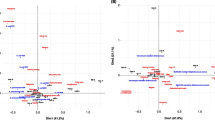Abstract
The aim of this study was to investigate the bacterial pathogens involved in pediatric urinary tract infections (UTIs) in a tertiary general hospital located in the Thrace province of Northern Greece over a 69-month period (1/2003 to 9/2008), and their antibiotic susceptibility patterns. A total of 622 episodes of UTIs in 508 children were identified. Median age of all children was 16 months (range 1 month to 14 years). Boys were significantly younger than girls (9 months vs. 24 months). Escherichia coli was the most common uropathogen and responsible for 69.1% of UTIs. Approximately half of E. coli isolates were resistant to ampicillin and 20.5% to trimethoprim/sulfamethoxazole (TMP/SMX). E. coli resistance to second-generation and third-generation cephalosporins was <4%, to aminoglycosides <8%, and to nitrofurantoin 4.4%. Pediatric E. coli urine isolates were significantly more resistant to ampicillin and ticarcillin and more sensitive to quinolones compared to adult E. coli uropathogens identified in the same hospital. E. coli resistance to ampicillin and amoxicillin/clavulanic acid was significantly higher in boys 12–23 months-old compared to girls of the same age. In conclusion, nitrofurantoin is a very good choice for chemoprophylaxis. Amoxicillin/clavulanic acid, second-generation cephalosporins, and TMP/SMX are appropriate choices for oral empirical treatment of UTIs. Parenteral aminoglycosides and second and third-generation cephalosporins are excellent treatment choices for inpatient therapy. Finally, sex and age are additional factors that should be taken into account when choosing empirical therapy for children with UTIs.
Similar content being viewed by others
Abbreviations
- UTI(s):
-
Urinary tract infection(s)
- ASP:
-
Antibiotic Susceptibility Patterns
- UGDHA:
-
University General District Hospital of Alexandroupolis
- CFU(s):
-
Colony forming unit(s) MICs, minimal inhibitory concentrations
- TMP/SMX:
-
Trimethoprim/sulfamethoxazole
- CLSI:
-
Clinical and Laboratory Standards Institute
References
Hoberman A, Chao HP, Keller DM, Hickey R, Davis HW, Ellis D (1993) Prevalence of urinary tract infection in febrile infants. J Pediatr 123:17–23
Wennerström M, Hansson S, Jodal U, Sixt R, Stokland E (2000) Renal function 16 to 26 years after the first urinary tract infection in childhood. Arch Pediatr Adolesc Med 154:339–345
Kahlmeter G, Menday P (2003) Cross-resistance and associated resistance in 2478 Escherichia coli isolates from the Pan-European ECO.SENS Project surveying the antimicrobial susceptibility of pathogens from uncomplicated urinary tract infections. J Antimicrob Chemother 52:128–131
Ladhani S, Gransden W (2003) Increasing antibiotic resistance among urinary tract isolates. Arch Dis Child 88:444–445
Sahm DF, Thornsberry C, Mayfield DC, Jones ME, Karlowsky JA (2001) Multidrug-resistant urinary tract isolates of Escherichia coli: prevalence and patient demographics in the United States in 2000. Antimicrob Agents Chemother 45:1402–1406
Practice parameter: the diagnosis, treatment, and evaluation of the initial urinary tract infection in febrile infants and young children. American Academy of Pediatrics. 1999 Committee on Quality Improvement. Subcommittee on Urinary Tract Infection. Pediatrics 103:843–852
Clinical and Laboratory Standards Institute (2005) Performance standards for antimicrobial susceptibility testing; Approved standard. CLSI Document M100-S15. Wayne, PA, USA
Shortliffe LM, McCue JD (2002) Urinary tract infection at the age extremes: pediatrics and geriatrics. Am J Med 113(Suppl 1A): 55S–66S
Wu CY, Chiu PC, Hsieh KS, Chiu CL, Shih CH, Chiou YH (2004) Childhood urinary tract infection: a clinical analysis of 597 cases. Acta Paediatrica Taiwanica 45:328–333
Abelson Storby K, Osterlund A, Kahlmeter G (2004) Antimicrobial resistance in Escherichia coli in urine samples from children and adults: a 12 year analysis. Acta Paediatr 93:487–491
Al-Harthi AA, Al-Fifi SH (2008) Antibiotic resistance pattern and empirical therapy for urinary tract infections in children. Saudi Med J 29:854–858
Al-Mugeiren MM, Qadri SM (1996) Bacteriologic profile and drug resistance in pediatric patients with symptomatic bacteriuria. Clin Ther 18:295–300
Allen UD, MacDonald N, Fuite L, Chan F, Stephens D (1999) Risk factors for resistance to “first-line” antimicrobials among urinary tract isolates of Escherichia coli in children. CMAJ 160:1436–1440
Goldraich NP, Manfroi A (2002) Febrile urinary tract infection: Escherichia coli susceptibility to oral antimicrobials. Pediatr Nephrol 17:173–176
Haller M, Brandis M, Berner R (2004) Antibiotic resistance of urinary tract pathogens and rationale for empirical intravenous therapy. Pediatr Nephrol 19:982–986
Lutter SA, Currie ML, Mitz LB, Greenbaum LA (2005) Antibiotic resistance patterns in children hospitalized for urinary tract infections. Arch Pediatr Adolesc Med 159:924–928
McLoughlin TG Jr, Joseph MM (2003) Antibiotic resistance patterns of uropathogens in pediatric emergency department patients. Acad Emerg Med 10:347–351
Anatoliotaki M, Galanakis E, Schinaki A, Stefanaki S, Mavrokosta M, Tsilimigaki A (2007) Antimicrobial resistance of urinary tract pathogens in children in Crete, Greece. Scand J Infect Dis 39:671–675
Fritzsche M, Ammann RA, Droz S, Bianchetti MG, Aebi C (2005) Changes in antimicrobial resistance of Escherichia coli causing urinary tract infections in hospitalized children. Eur J Clin Microbiol Infect Dis 24:233–235
Suman E, Bhat KG (2001) Urinary tract infection in children due to drug-resistant bacteria–a study from south India. J Trop Pediatr 47:374–375
Jensen-Fangel S, Mohey R, Johnsen SP, Andersen PL, Sørensen HT, Ostergaard L (2004) Gender differences in hospitalization rates for respiratory tract infections in Danish youth. Scand J Infect Dis 36:31–36
Yüksel S, Oztürk B, Kavaz A, Ozçakar ZB, Acar B, Güriz H et al (2006) Antibiotic resistance of urinary tract pathogens and evaluation of empirical treatment in Turkish children with urinary tract infections. Int J Antimicrob Agents 28:413–416
Chong CY, Tan AS, Ng W, Tan-Kendrick A, Balakrishnan A, Chao SM (2003) Treatment of urinary tract infection with gentamicin once or three times daily. Acta Paediatr 92:291–296
Hodson EM, Willis NS, Craig JC (2007) Antibiotics for acute pyelonephritis in children. Cochrane Database Syst Rev 4:CD003772
Gottesman BS, Carmeli Y, Shitrit P, Chowers M (2009) Impact of quinolone restriction on resistance patterns of Escherichia coli isolated from urine by culture in a community setting. Clin Infect Dis 49:869–875
Conflicts of interest statement
None.
Author information
Authors and Affiliations
Corresponding author
Additional information
An erratum to this article can be found at http://dx.doi.org/10.1007/s11255-010-9797-5
Rights and permissions
About this article
Cite this article
Mantadakis, E., Tsalkidis, A., Panopoulou, M. et al. Antimicrobial susceptibility of pediatric uropathogens in Thrace, Greece. Int Urol Nephrol 43, 549–555 (2011). https://doi.org/10.1007/s11255-010-9768-x
Received:
Accepted:
Published:
Issue Date:
DOI: https://doi.org/10.1007/s11255-010-9768-x




